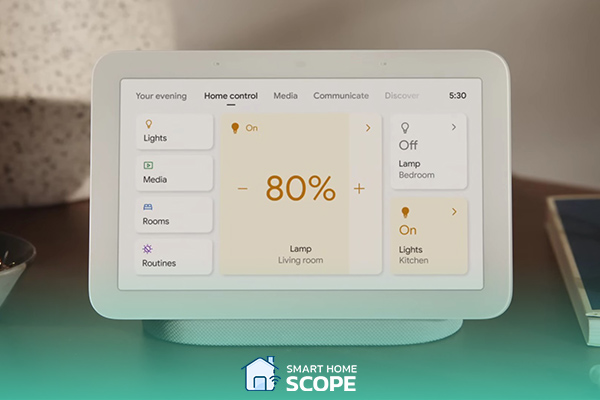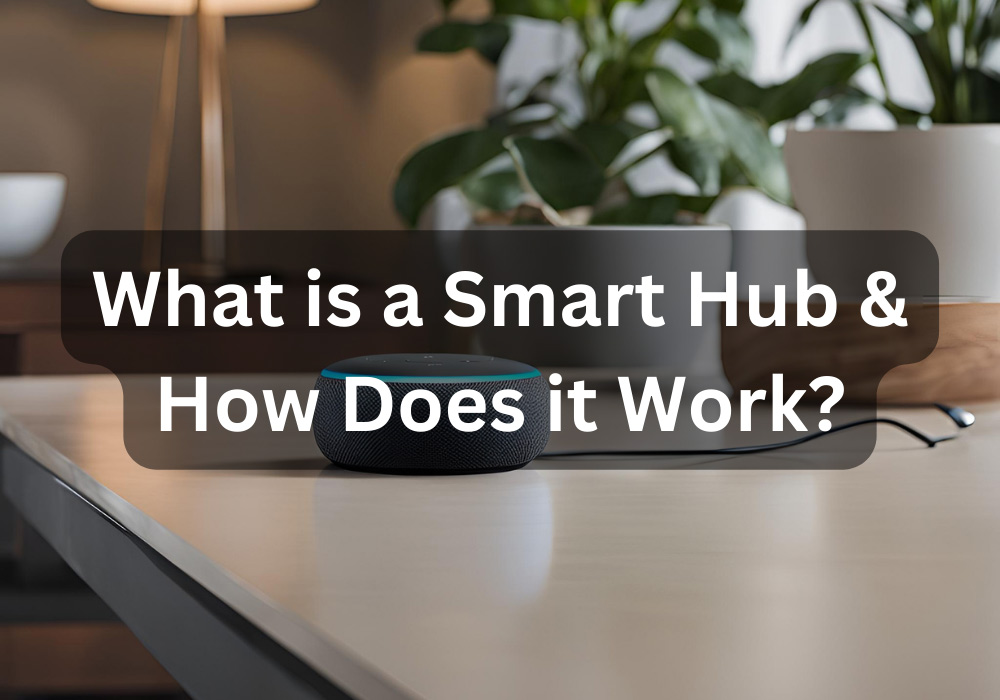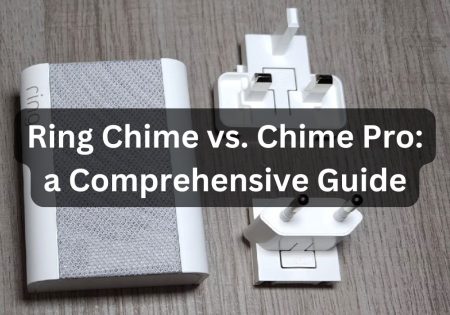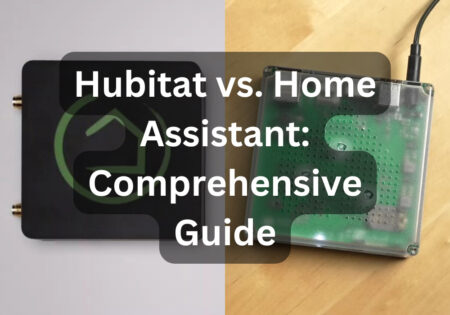A smart hub is the central device in a smart home system, like the most important piece in a big puzzle. Let’s dive deep into this matter to figure out: what is a smart hub and how does it work? In this article, I’ll explain everything you need to know about these central hubs, from the devices they can control like lights and thermostats, to their robust integration with popular voice assistants like Alexa or Siri, and many more.
What is a Smart Hub?
A smart home hub is a hardware or software platform that acts as the central command system of a smart home setup. With a smart hub, you can make various devices (from smart thermostats to lights) communicate with each other and manage them from a single interface. Its overall role is to unify your devices to work seamlessly in a cohesive system.
There are various types of smart hubs, including:
- Dedicated Smart Hubs: These are standalone devices specifically made to manage smart home systems. One of the most popular examples of this type is the Samsung SmartThings hub.
- Integrated Smart Hubs: These smart hubs come built into other smart devices. They can be a smart speaker or display while also acting as a smart hub. For instance, Amazon Echo is a smart speaker that comes with Alexa, Amazon’s voice assistant, enabling voice control over many compatible devices. This type of hub is convenient as it provides thorough control over your devices and offers a streamlined experience of voice control—all with a single device.
- Software-Based Smart Hubs: These are apps or cloud services that make managing your devices possible without the need for additional hardware. These are streamlined solutions to automate and control your smart home devices using your smartphone, PC, or any other device with a compatible OS. Examples include:
- Apple HomeKit: It’s manageable through the Home app on iOS devices. The automation that HomeKit provides is robust, and voice control is possible with Siri. It’s definitely the go-to choice for Apple lovers.
- Samsung SmartThings App: This app, while fully compatible with the dedicated SmartThings hub, is also very capable of managing devices over Wi-Fi and acting as a software-based hub.
A smart home hub is the epicenter, seamlessly orchestrating and harmonizing connected devices.
How do Smart Hubs Work?
As I told you earlier, a smart hub’s job is to control and manage all of your devices. The first question that comes to mind is: how does it communicate with other devices? The answer is simple—it uses technologies known as communication protocols.
Consider these communication protocols as the language that lets smart devices talk to each other. The most important communication protocols are:
- Wi-Fi
- Zigbee
- Z-Wave
- Bluetooth
For instance, Hubitat C7 and C8 are two popular smart hubs from Hubitat that support Wi-Fi, Zigbee, and Z-Wave; I suggest you read my Hubitat C8 vs. C7 guide.; also, To gain more information on these technologies and their differences, I suggest you read the article below:
Also Read:
OK, so you know the language that a smart hub uses to talk with other devices. The next question is: how does the hub centralize the control of your devices? Here’s the process:
- Device Pairing: The first step is to pair the new device with the hub. The hub will store its information and manage its communication.
- Central Interface: The hub provides a central interface (often an app) where you can manage every device within the ecosystem.
- Automation Rules: This is the most interesting part. You can set up scenarios called routines or scenes to automate everyday tasks. For example, you can program the hub to turn on the lights and change the temperature when you arrive home.
- Voice Control: Smart hubs like Amazon Echo or Google Nest let you control your devices using only your voice.
What are the Most Popular Smart Hubs?
Now that you’re aware of the types of smart hubs, it’s time to get to know the most famous ones. Each of these nominees has its own strengths and is suited for specific needs. Additionally, every hub from a brand creates its own unique platform that a smart home can be based on:
Samsung SmartThings

This one is the most reliable in terms of compatibility with a wide range of devices. SmartThings supports protocols such as Zigbee and Z-Wave, making it a great choice for IoT devices that use these communication protocols. SmartThings integrates smoothly with Samsung products like appliances and TVs, along with a wide range of third-party devices.
It offers the dedicated SmartThings hub along with the SmartThings app to control all your devices remotely. Among all the hubs introduced in this article, it’s the only option that’s compatible with Wi-Fi, Z-Wave, and Zigbee at the same time.
Amazon Echo

Amazon Echo devices, which include the Amazon Echo Dots and Echo Shows, come with Alexa voice assistant and act as a smart speaker/display and a smart hub at the same time, allowing users to control Alexa-compatible devices.
Trust me, there are lots of them. Every Echo device supports Wi-Fi; additionally, Zigbee is supported on some models like the Echo Show (2nd Gen, 3rd Gen, and 10), which allows them to communicate with devices compatible with Zigbee. There’s also the Alexa app that provides robust control of all the devices within the Alexa ecosystem.
Google Nest Hub

Google Nest hubs, which include the Nest Hub and Nest Hub Max, come with a visual interface just like Echo Show devices. Google’s hubs are compatible with every Nest device and a bunch of third-party devices like Philips Hue smart lights, Arlo and Ring cameras and doorbells, ADT smart home security systems, and many more.
Apple HomePod

Apple HomePod is a smart speaker that’s also a smart hub for those who have built their smart setup with Apple products. This device integrates seamlessly with Apple’s HomeKit framework, meaning you can manage and control every HomeKit-enabled device with it.
Apple HomePod comes equipped with Siri as a trustworthy voice assistant to help you control your devices using just your voice. Similar to Google Nest Hub, this one supports Wi-Fi and Bluetooth for communication. Third-party compatibility isn’t as common as other contenders, but it’s still acceptable. You can also control your HomeKit devices using the Home app.
Honorable Mentions
In addition to the hubs I already told you about, I can’t skip two other big names. One is Hubitat, which is very popular with its Hubitat Elevation hubs, and the other is Home Assistant, which is the best option for those who want to implement multi-layered and sophisticated automation in their smart home. I mean, everything is possible with Home Assistant. I suggest you read my Hubitat vs. Home Assistant guide for more on this.
What are the Advantages of Smart Hubs?
Interoperability and Enhanced Automation
A smart hub can make devices from different manufacturers work together. For example, a Zigbee smart bulb can work with a Z-Wave motion sensor from another brand, all managed through one single smart hub. This allows high automation capabilities in your smart home. For example, you can set a morning routine where, at a specific time, the coffee machine starts working, the lights turn on, and music starts to play.
Remote Access and Simplified Control
As I’ve already mentioned, a smart hub lets you manage all your devices remotely from anywhere using an app. This way, you can control and monitor your home anytime you want. This is particularly a great advantage for ensuring the security of your home. For example, you can view live feeds, control your smart locks, manage lights, temperature, and pretty much anything you desire in your smart ecosystem remotely.
Enhanced Security and Monitoring
With a robust smart hub, you can integrate many smart security devices like smart locks, cameras, and sensors together to create a cohesive setup that can be monitored remotely, send you security notifications, and help you automate many security tasks. For example, when you’re away, if the cameras detect unusual activity around your house, the hub sends you an alert and triggers the cameras to start recording.
Energy Efficiency and Cost Savings
The automation offered by a reliable smart hub leads to a noticeable decrease in energy consumption. For example, you can set the thermostat to change the temperature based on your daily routine, ensuring that your HVAC system operates only when needed.
What are the Disadvantages of Smart Hubs?
Security and Privacy Concerns
While smart hubs can be beneficial for the security of smart homes, they can be vulnerable to security breaches if you don’t set them up properly. If hackers gain access to your setup, they can control everything, mess with your thermostat, turn off cameras, listen to your voice recordings, and anything associated with your smart hub. This leads to many security and privacy concerns. To prevent such events from happening, I suggest you read the article mentioned in this paragraph.
Compatibility Issues
Not all smart hubs offer extensive compatibility across different brands and devices. Not all smart devices use the same communication protocols. For example, your device may use Zigbee, while your hub only supports Wi-Fi and Bluetooth. So, if you’ve already invested in some smart devices, it’s important to consider their compatibility with the hub you’re willing to buy.
Cost Considerations
Smart hubs offer many benefits, but they can also be expensive. There’s the initial cost of the hub itself, plus the compatible devices. In addition, some hubs require subscription fees for advanced features or cloud services, which we call hidden costs. If you’re an Alexa lover, I suggest you read our guide on the hidden costs of Alexa.
Dependence on Internet and Power
Some hubs offer offline functionality, but most of them demand a smooth internet connection. If the internet goes down or a power outage occurs, your smart devices and your hub become inoperable.
Conclusion
To conclude this article, I can say that a smart hub is mostly necessary in a smart home setup. You can’t have a soccer team without a manager! Despite the security, compatibility, and cost concerns, I say definitely go for one. I hope that now you know what a smart hub is and how it works.
FAQs
Can You Use a Smart Hub Without the Internet?
Yes, but not without limitations. There are smart hubs like the Samsung SmartThings that support other communication protocols like Zigbee and Z-Wave, but for features like remote monitoring and security notifications, your hub needs to be connected to the web.
Is a Smart Hub the Same as a Router?
No, they are two different devices with distinct features. A router manages your network and enables devices to gain access to the internet. On the other hand, a smart hub manages communication among various devices in your smart home setup. It manages and automates tasks done by your gadgets.
What Do I Need a SmartThings Hub for?
This hub supports many communication protocols, so it can help devices from different manufacturers interact with each other. For example, if you have a SmartThings hub, a device that uses Zigbee can communicate with another device that supports Z-Wave.
Is Alexa a Smart Hub?
Yes, Alexa can function as a smart hub, particularly on Amazon Echo Plus and Echo Show devices that support Zigbee. This feature enables them to connect and control many devices. In addition, Alexa supports many third-party devices, allowing it to provide centralized control that is further enhanced by voice commands.










